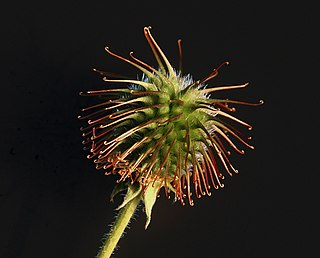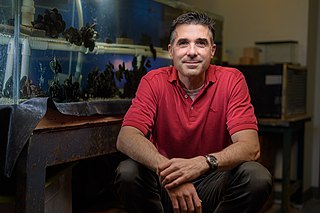
Biomimetics or biomimicry is the emulation of the models, systems, and elements of nature for the purpose of solving complex human problems. The terms "biomimetics" and "biomimicry" are derived from Ancient Greek: βίος (bios), life, and μίμησις (mīmēsis), imitation, from μιμεῖσθαι (mīmeisthai), to imitate, from μῖμος (mimos), actor. A closely related field is bionics.

The Land Institute is an American nonprofit research, education, and policy organization dedicated to sustainable agriculture, based in Salina, Kansas. Their goal is to develop an agricultural system based on perennial crops that "has the ecological stability of the prairie and a grain yield comparable to that from annual crops".
Janine M. Benyus is an American natural sciences writer, innovation consultant, and author. After writing books on wildlife and animal behavior, she coined the term Biomimicry to describe intentional problem-solving design inspired by nature. Her book Biomimicry (1997) attracted widespread attention from businesspeople in design, architecture, and engineering as well as from scientists. Benyus argues that by following biomimetic approaches, designers can develop products that will perform better, be less expansive, use less energy, and leave companies less open to legal risk.

Bionics or biologically inspired engineering is the application of biological methods and systems found in nature to the study and design of engineering systems and modern technology.
Bionic architecture is a contemporary movement that studies the physiological, behavioural, and structural adaptions of biological organisms as a source of inspiration for designing and constructing expressive buildings. These structures are designed to be self-sufficient, being able to structurally modify themselves in response to the fluctuating internal and external forces such as changes in weather and temperature.

The Buckminster Fuller Challenge is an annual international design competition that awards $100,000 to the most comprehensive solution to a pressing global problem. The Challenge was launched in 2007 and is a program of The Buckminster Fuller Institute. The competition, open to designers, artists, architects, students, environmentalists, and organizations world-wide, has been dubbed "Socially-Responsible Design's Highest Award" by Metropolis Magazine.
Environmentally sustainable design is the philosophy of designing physical objects, the built environment, and services to comply with the principles of ecological sustainability and also aimed at improving the health and comfort of occupants in a building. Sustainable design seeks to reduce negative impacts on the environment, the health and well-being of building occupants, thereby improving building performance. The basic objectives of sustainability are to reduce the consumption of non-renewable resources, minimize waste, and create healthy, productive environments.

Bio-inspired robotic locomotion is a subcategory of bio-inspired design. It is about learning concepts from nature and applying them to the design of real-world engineered systems. More specifically, this field is about making robots that are inspired by biological systems, including Biomimicry. Biomimicry is copying from nature while bio-inspired design is learning from nature and making a mechanism that is simpler and more effective than the system observed in nature. Biomimicry has led to the development of a different branch of robotics called soft robotics. The biological systems have been optimized for specific tasks according to their habitat. However, they are multifunctional and are not designed for only one specific functionality. Bio-inspired robotics is about studying biological systems, and looking for the mechanisms that may solve a problem in the engineering field. The designer should then try to simplify and enhance that mechanism for the specific task of interest. Bio-inspired roboticists are usually interested in biosensors, bioactuators, or biomaterials. Most of the robots have some type of locomotion system. Thus, in this article different modes of animal locomotion and few examples of the corresponding bio-inspired robots are introduced.
This is a bibliography of sustainability publications.
Biomimetic architecture is a branch of the new science of biomimicry defined and popularized by Janine Benyus in her 1997 book. Biomimicry refers to innovations inspired by nature as one which studies nature and then imitates or takes inspiration from its designs and processes to solve human problems. The book suggests looking at nature as a Model, Measure, and Mentor", suggesting that the main aim of biomimicry is sustainability.

Jonathan Wilker is an American scientist, engineer, and educator who focuses on developing marine animal-inspired underwater adhesives for use in surgery, construction, and other applications. His work has been profiled by The New York Times, National Public Radio, Popular Science, and his research findings appear in many scientific journals, such as Nature, Journal of the American Chemical Society, and ACS Applied Materials & Interfaces. He is a professor at Purdue University in West Lafayette, Indiana, where he teaches courses in inorganic chemistry and bioinorganic chemistry. Wilker has received a number of awards for his teaching including The College of Science Outstanding Teacher Award at Purdue University (2011). In addition to being in the Department of Chemistry, he is also a Professor of Materials Engineering at Purdue University. Outside activities include advocacy for federal funding of science research and development.

Love Thy Nature is a 2014 documentary film directed by Sylvie Rokab and narrated by Liam Neeson. The film underwent development in the mid-2000s, with production lasting nearly a decade. Produced and distributed by In The Light Productions, the first version of the film premiered on 18 October 2014 at the Hollywood Film Festival, with a film festival run throughout 2014 and 2015 and a theatrical run with the final version of the film in 2016. It has had over 300 theatrical and community screenings in 140 cities in 16 countries, earned 27 awards, and was covered in 28 publications.

Franco Lodato is an Italian-American industrial designer, best known for his work in biomimicry and sustainable design. He owns more than 70 patents across multiple industries.
Ecopreneurship is a term coined to represent the process of principles of entrepreneurship being applied to create businesses that solve environmental problems or operate sustainably. The term began to be widely used in the 1990s, and it is otherwise referred to as "environmental entrepreneurship." In the book Merging Economic and Environmental Concerns Through Ecopreneurship, written by Gwyn Schuyler in 1998, ecopreneurs are defined as follows:
"Ecopreneurs are entrepreneurs whose business efforts are not only driven by profit, but also by a concern for the environment. Ecopreneurship, also known as environmental entrepreneurship and eco-capitalism, is becoming more widespread as a new market-based approach to identifying opportunities for improving environmental quality and capitalizing upon them in the private sector for profit. "
Michael Pawlyn is a British architect noted for his work in the field biomimetic architecture and innovation, as well as jointly initiating the 'Architects Declare' movement in the UK. He was part of the principal team of architects that conceived and designed The Eden Project and is a regular keynote speaker at events on innovation and environmental sustainability. His best selling RIBA book Biomimicry in Architecture was published in 2011 and a revised second edition, with a foreword by Ellen MacArthur, was published in 2016. He was one of the three founders of The Sahara Forest Project - a way of supplying fresh water, food and renewable energy in arid conditions - and remains actively involved as a Founding Partner and Design Manager.

Exploration Architecture was established in 2007 by architect Michael Pawlyn.
Bioinspiration refers to the human development of novel materials, devices, structures, and behaviors inspired by solutions found in biological organisms, where they have evolved and been refined over millions of years. The goal is to improve modeling and simulation of the biological system to attain a better understanding of nature's critical structural features, such as a wing, for use in future bioinspired designs. Bioinspiration differs from biomimicry in that the latter aims to precisely replicate the designs of biological materials. Bioinspired research is a return to the classical origins of science: it is a field based on observing the remarkable functions that characterize living organisms and trying to abstract and imitate those functions.

Robin L. Garrell is an American chemist, academic and former president of The Graduate Center, CUNY. Until 2020, Garrell served as vice provost for graduate education and dean of graduate division at University of California, Los Angeles (UCLA). Prior to this role, Garrell was assistant professor at the University of Pittsburgh from 1984 to 1991, then joined the faculty in the department of chemistry and biochemistry at UCLA, where she became full professor and held a joint appointment in bioengineering. Garrell assumed her current position at The Graduate Center on August 1, 2020. </ref> On August 28, 2023 she announced that she would be stepping down as president of the CUNY Graduate Center effective September 29, 2023.
Javier G. Fernandez is a Spanish physicist and bioengineer. He is associate professor at the Singapore University of Technology and Design. He is known for his work in biomimetic materials and sustainable biomanufacturing, particularly for pioneering chitin's use for general and sustainable manufacturing.
Ilaria Mazzoleni is an architect and founder of IM Studio Milano/Los Angeles. She is known for her work on sustainable architecture at all scales of design, and on biomimicry or design innovation inspired by nature. She has built work in Italy, California, and Ghana.










